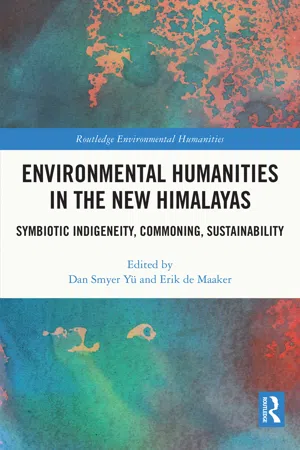Folkloric entrances
I open this chapter with an assemblage of folkloric narratives and myths, each of which variously accounts for the origins, social significance, and spiritual, symbolic and ontological status of yaks and herders in Bhutan’s and the surrounding highlands. The first narrative, or rather a variety of tales, concerns the early arrival of yaks in the highlands. The second narrative is told by Tibetan pastoralists, and with whom Bhutanese herders share a similar mythological complex, while the third comes from Lingzhi in the Bhutan highlands, which is the ethnographic locale from which this chapter emerges.
A well-known Bhutanese folktale tells that yak and buffalo once lived together in the lush meadows of southern Bhutan. Back then, both yaks and buffalos grew fur on their bodies. One day, buffalo told the yak about salt from the Tibetan area, which he heard was delicious. This made yak also curious to taste it. For that, however, they would have to travel a long distance and brave highlands and mountains on their way. Anxious about the cold weather there, the buffalo proposed he lend his fur to yak, who agreed. Once in the highlands, the yak found the salt delicious and the grasses fresh, so much so that he decided to remain there, in what today are the Bhutan highlands. Down in the meadows, the buffalo waited in vain for the yak’s return. This explains, the folktale concludes, why buffalo have little hair on their bodies, whereas yaks are furry and thick-haired. It further explains why yaks live in the highlands and buffalo in the lowlands, as well as why buffalos are often seen raising their heads to gaze in the distance, from where they still anticipate the yak to appear, carrying with him salt from Tibet.
This folktale has several variations, for instance versions that replace salt with butter, or that elevate the tale into the realm of the sacred by narrating that Guru Rinpoche (Padmasambhava) cursed the buffalo for defying nature by voluntarily shedding his fur and, as a punishment, permanently separated buffalos and yaks and sowed eternal enmity between them. A different narrative traces the presence of yaks in the Bhutan highlands to the arrival of the great Tibetan Lama Zhabdrung Ngawang Namgyal who came to Bhutan in the seventeenth century (more below) and blessed the highlands with a bounty of yaks. Yet another story holds that yaks were initially the cattle of a yeti but that humans overpowered him, stole his yaks and escorted them to the Bhutan highlands. What these tales commonly purport is that yaks have not always been in the highlands, but arrived there by circumstance.
The second meta-narrative concerns the shifting terrain of power, standing, authority, rights and dominion between yaks and humans. It tells that in the deep past, yaks enjoyed a sacred or supernatural status and were part of an expansive pantheon of deities. Humans, in contrast, survived on a much lower and more subservient strata within the earthly and cosmic hierarchy. Yaks’ initial descent on earth, in the Himalayas and the Tibetan Plateau, therefore lent them a superior position, akin to the gods of the earth, and they exerted control over humans. Gradually, however, and for a range of reasons, humans evolved and eventually elevated themselves above yaks, whom they subsequently subjected to human utilitarian and functional purposes such as transportation, fibre for making tents, ropes and whips, as well as for the occasional protein. After the introduction and spread of Buddhism in the region, which in parts replaced and in parts mingled with pre-existing Bon and animistic belief practices, yaks became fully reduced as exclusively belonging to the animal realm, one of the undesirable realms to be (re)born into, and were thus permanently positioned lower in hierarchy compared to humans. This explains why humans today herd yaks, instead of, as was a possibility in the mythical past, yaks herding humans.1
The third narrative is a story widely told in Lingzhi. It tells of an ancestor by the name of Madhagoki who herded thousands of yaks. Madhagoki was flourishing because he enjoyed the benevolence and protection of Jo-Gyem, a powerful deity within an all-encompassing and hierarchically constituted cosmic order that consisted of lha (enlightened beings), lhu (serpents), dhe (evil spirits), tshen (personal guardians), nep (spiritual proprietors of a territory) and other spirits that called the Lingzhi area their home. Each year, Madhagoki sacrificed his most prized yak to Jo-Gyem, who in return bestowed fortune on him. One year, however, he decided to offer Jo-Gyem a horse instead of a yak. In those days, horses were scarce, rare and therefore particularly precious in the highlands and Madhagoki, in good faith, thought that a horse might please Jo-Gyem even more than his best yak. As Madhagoki ritually sacrificed a horse and offered its meat and blood to Jo-Gyem, the deity’s voice echoed through the mountains, asking Madhagoki: “Should I let it go?” Madhagoki interpreted this question as Jo-Gyem offering him even greater riches and he immediately responded: “Let it go!” No sooner, Jo-Gyem made a lake burst and which flooded Madhagoki’s village, washing away lives and property.
This story carries multiple meanings, all of which are constitutive of the highland ontological matrix. First, that worldly well-being and fortune cannot be established and maintained without the explicit protection and care of the territorial deities, who demand reverence through ritual sacrifices and offerings in return. Second, that irrespective of material or monetary value attached to other nonhuman animals such as horses, only yaks are ascribed with the spiritual potency that quality for sacrificial offering. And third, that deities, when angered, can exert punishment and revenge through causing natural calamities and by inducing destruction and misfortune.
